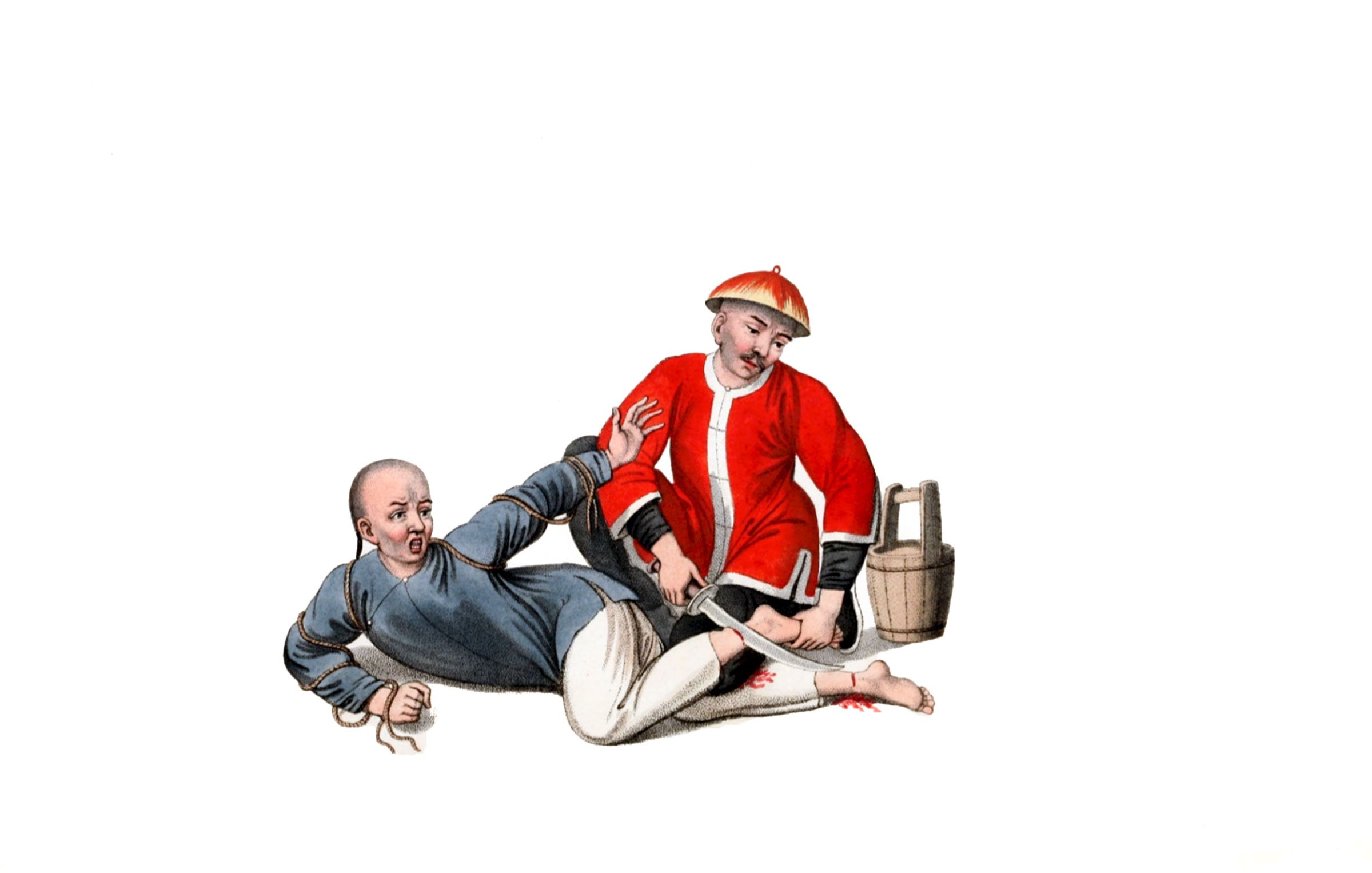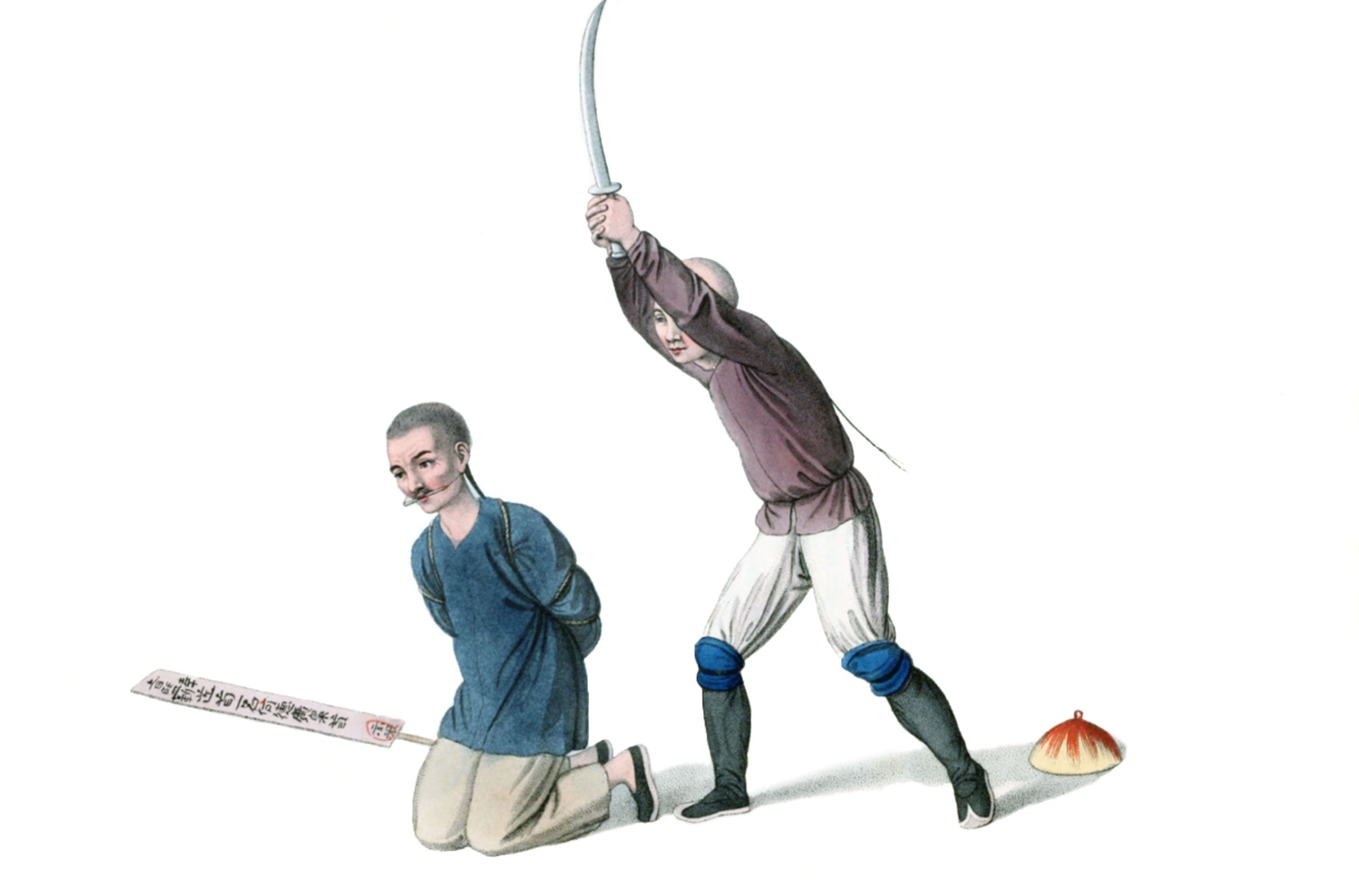The Punishments of China in the 18th Century
A Culprit Before the Magistrate
It is a custom in China, for a Mandarin of justice to administer it daily, morning and evening, in his own house, where he is attended by his secretary, or clerk, and by inferior officers, some of them bearing shackles. Upon his right hand stands the Prosecutor and before him with a covering of silk, and the implements of writing for the secretary to take down the depositions and defense. If a culprit is convicted of a petty offense, the magistrate causes him to be immediately chastised, and released. The usual punishment is the bastinade and a number of blows to be inflicted. Whenever the crime calls for a more severe punishment, it is generally examined by five or six tribunals.
A Culprit Conducted to Trial
He is preceded by a man, who strikes upon a gong, in order to draw upon the offender, the notice of the public. Two others walk after him, one of whom is employed in keeping up his face with a bundle of cleft canes. A little red banner is fastened on each side of the culprit, to render him more conspicuous, and his hands are tied behind his back.
An Offender Undergoing the Bastinade
He is thrown flat upon his face and held in that position by one, or more, if necessary, of the magistrate’s attendants kneeling upon his back, whilst another applies the pan-tsee to his posteriors.
The pan-tsee is a thick piece of split bamboo cane, the lower end of which is about four inches in width, and the upper end small and smooth, to render the instrument more convenient for the hand. Mandarins of power have usually some persons in their train, who attend them with these pan-tsees, whenever they travel, or go into public, and who are ready, at the nod of their master, to exercise their office in the manner described. After this ceremony, it is customary for the delinquent to return thanks to the Mandarin, for the good care he takes of his education.
Twisting a Man’s Ear
He is held securely by two men, in the service of a tribunal, who are instructed to give pain, by a particular method of twisting the cartilages of the ears.
Punishment of the Swing
This man is suspended by his shoulders and ankles, in a very painful situation: at intervals, two attending officers afford some trifling alleviation of his sufferings, by supporting him with a bamboo, passed under his breast. Pencil, ink, and paper, are ready to note down whatever he may say.
This punishment, together with the preceding one, is chiefly inflicted upon such merchants as have detected in committing frauds, impositions, or an other unwarrantable tricks of trade.
Punishing a Boatman
A species of correction appointed for boatmen, or, as they are termed in England, watermen. Having been convicted of some misbehavior, he is compelled to kneel: one of the officers of justice prevents him from flinching, whilst another grasps his hair, and bestows a certain number of blows upon each side of his face, with a sort of double battledore, made of thick leather.
Punishing an Interpreter
A large piece of bamboo cane is placed behind his knees; this is trampled upon by two men, one standing on each end, and who convey more or less pain, as they approach to, or recede from, his person. A punishment, decreed against interpreters, detected of wilful mininterpretation.
The Rack
This horrible engine of barbarity and error is not peculiar to Roman Catholic countries, it used even in China, for the purpose of extorting confession. The method of employing it, in torturing the ankles, is exhibited. The instrument is composed of a thick, strong plank, having a contrivance at one end to secure the hands, and at the other a sort of double wooden vice. The chief tormentor then gradually introduces a wedge into the intervals, alternately changing sides. This method compresses the ankles of the sufferer.
Torturing the Fingers
This is effected by placing small pieces of wood betwixt them, and then drawing them very forcibly together with cords. It is frequently inflicted as a punishment upon disorderly women.
Burning A Man's Eye With Lime
A small quantity of unslacked lime is put into pieces of cotton cloth, and closely applied to the organs of sight.
A Culprit Conveyed to Prison
An iron chain, fastened by a padlock, is put around his neck, and if he refuses to proceed, inferior officers of justice compel him, after the manner described.
A Malefactor Chained to an Iron-Bar
The links, sliding upon the bar, accomodate themselves to the motions of the prisoner; the small piece of plank, that is attached to the shackles, serves him for a seat. From the top of the bar, there depends a little board, upon which the name and crime of the malefactor are inscribed.
The Punishment of the Wooden-Collar
This punishment is deemed very disgraceful. The collar is formed of heavy pieces of wood, closed together, and having a hole in the center, which fits the neck of the offender, who, when this machine is upon him, can neither see his own feet, nor put his hands to his mouth. He is not permitted to reside in any habitation, nor even to take rest for any considerable length of time.
A Man Fastened to a Large Block of Wood
A strong ring of iron is passed through one corner of a short, heavy piece of timber. From this ring, a weighty chain is continued round the neck of the man, and fastened, by a padlock, upon his chest.
A Malefactor in a Cage
This is farther secured by a chain from his neck to his ankle, from whence another chain proceeds, round one of the corner posts of his wooden cage, the entrance to which is through two moveable bars; these bars are fastened by an iron bolt, that passes through some staples, and is prevented from sliding, by a padlock.
Punishment of the Wooden Tube
A piece of bamboo cane is provided, which nearly corresponds with the height of the criminal, and is of considereable circumference. This bamboo being perfectly hallow, admits the passage of a large iron chain, one end of the which is rivitted around a stake, the other encircles his neck, and is confined there by a padlock.
Hamstringing a Malefactor
This punishment is reported to have been inflicted upon malefactors, who have endeavored to make their escape. A vessel containing Chunam, a species of mortar, is at hand, to be applied, by way of styptic, to the wounds.
Close Confinement
This criminal is fastened, at full length, upon a sort of bedstead, a chump of wood serving for a pillow. His hands and feet are loaded with iron manacles and fetters; his neck is chained to a post, and fastened by two padlocks.
Conducting an Offender into Banishment
A person, sentenced to transportation, is thus led, by an officer of justice, into the country appointed for his future recidency.
A Malefactor Conducted to Execution
The convict is fettered, and if he uses abusive or inflammatory language, gagged. His arms are pinioned behind his back, and he bears a board, on which are written his name, his crime, and his sentence.
The Capital Punishment of the Cord
The usual capital punishments China are strangling, and beheading. Criminals are sometimes strangled with a bow-string, but on general occasions, a cord is made use of, which fastens the person to a cross, and one turn being taken round his neck, it is drawn tight by an athletic executioner.
The Manner of Beheading
This sort of punishment, being deemed in the highest degree ignominious, is only inflicted for crimes, which are regarded by the Chinese government, as the most prejudicial to society; such as conspiracy, assassination, committing any offense against the person of the Emperor, or attempting the life of any of the imperial family; revolting, insurrection, striking a parent, or any other unnatural sort of crime.






















